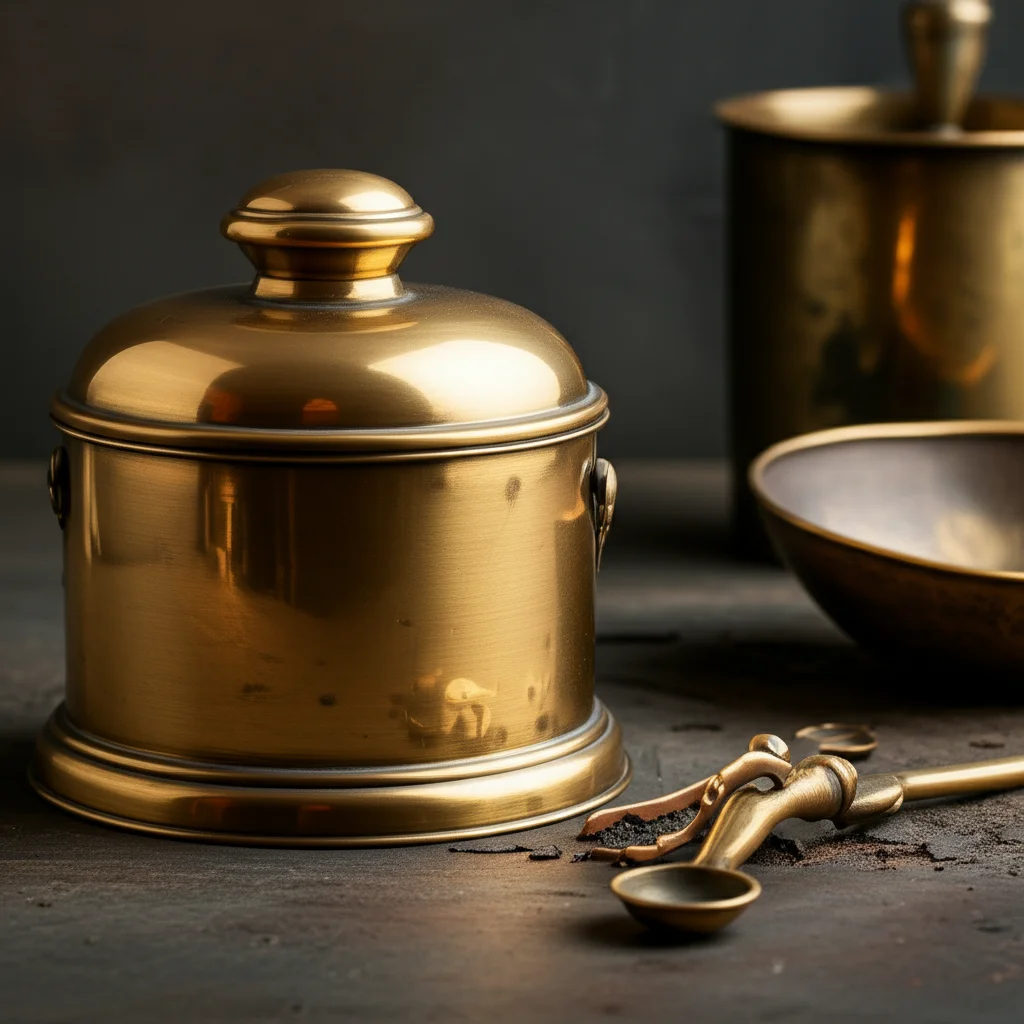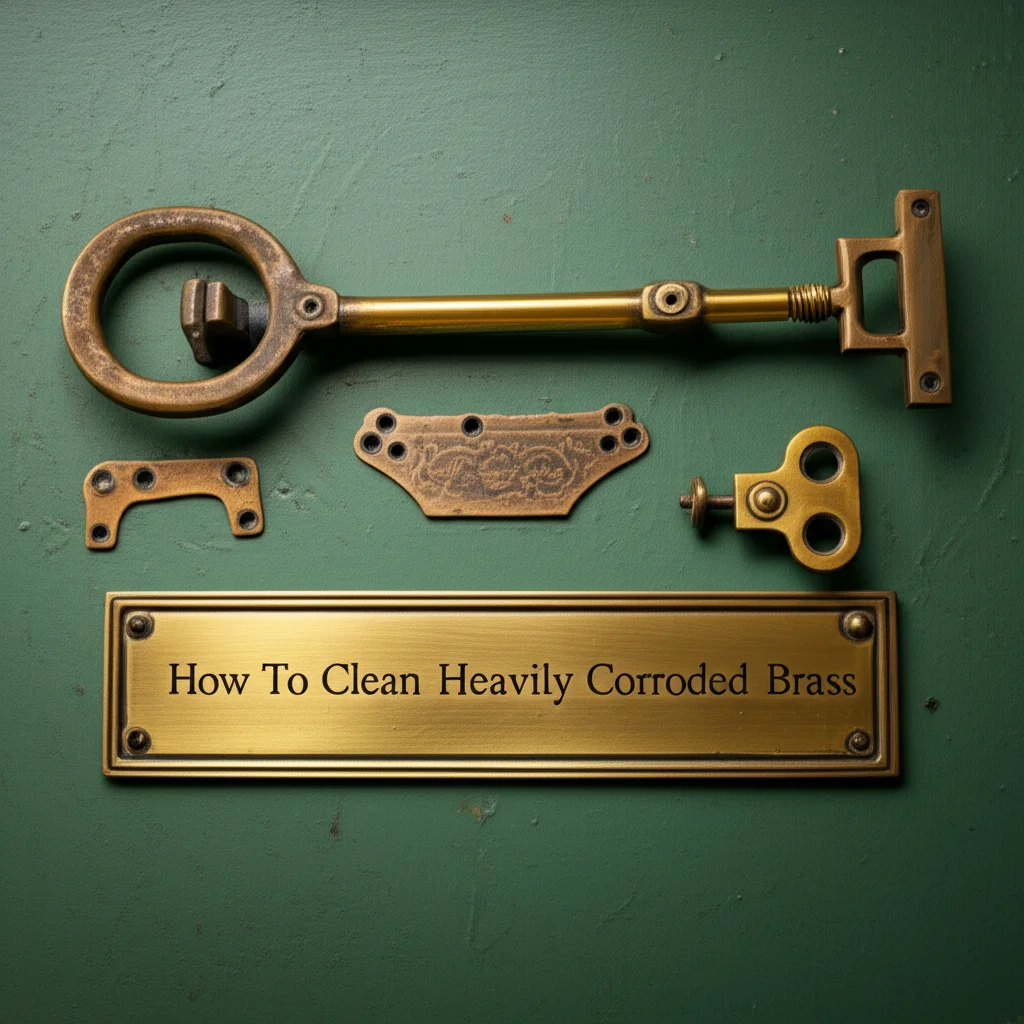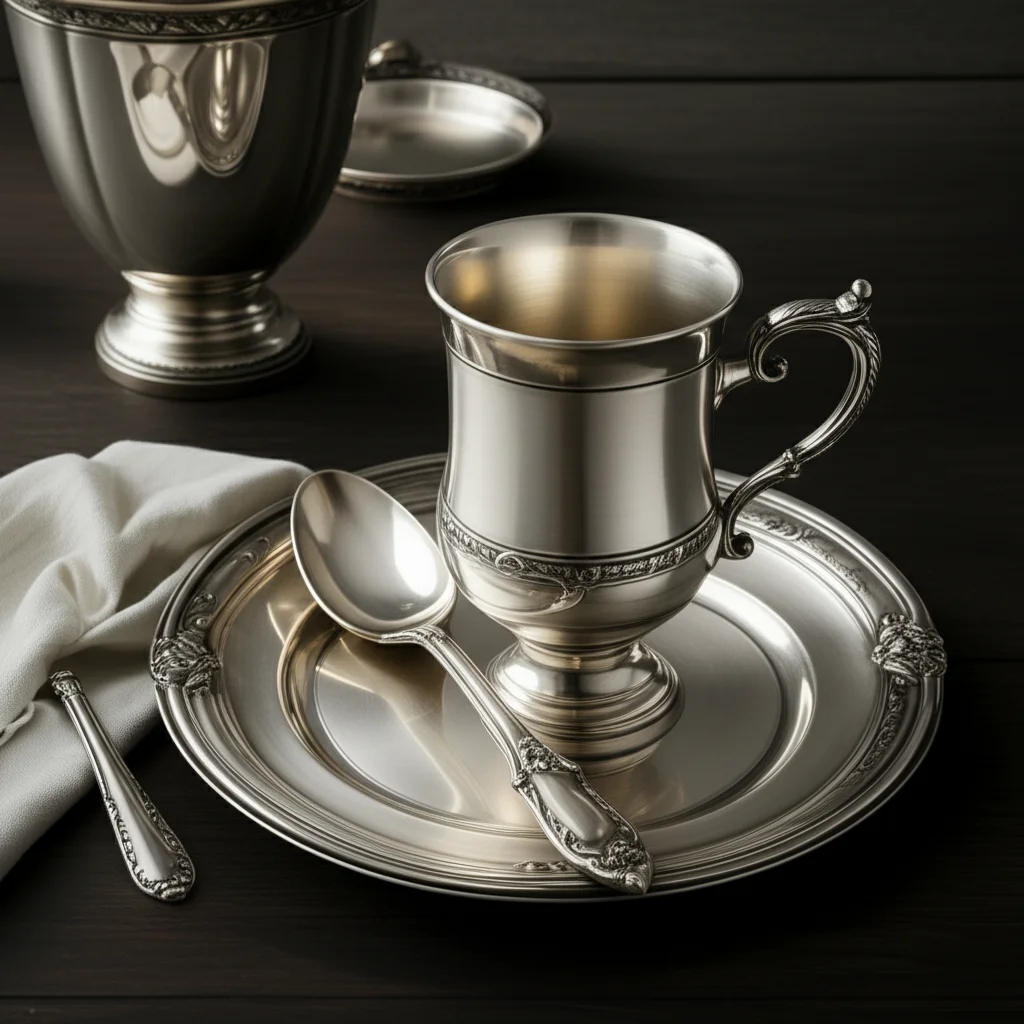· Kianna Connelly · Home Care · 13 min read
How To Clean Brass That Has Turned Black

Restore Blackened Brass: A Cleaning Guide
Brass items bring warmth and history to any space. Yet, over time, brass can lose its luster. It often turns black, losing its golden appeal. This darkening is due to oxidation, a natural process. This guide shows you how to clean brass that has turned black. You can bring back the shine to your beloved brass pieces. We cover simple methods and important care tips.
Takeaway:
- Identify if your brass is lacquered or unlacquered before cleaning.
- Use gentle homemade solutions like vinegar, salt, and flour for light tarnish.
- For heavy blackening, commercial cleaners or stronger acids might be necessary.
- Always test a small, hidden area first to avoid damage.
- Proper aftercare and regular cleaning prevent future blackening.
To clean brass that has turned black, you must remove the oxidized layer. Use a gentle abrasive like a lemon-salt paste or a baking soda solution. Apply the cleaner, let it sit, then rub gently. Rinse the brass thoroughly with water and dry it completely to reveal its golden shine.
Understanding Why Brass Turns Black
Brass is an alloy of copper and zinc. It reacts with oxygen and moisture in the air. This reaction creates a thin layer on the surface. This layer is called tarnish. Tarnish often appears as a dark, sometimes black, discoloration.
The Science of Brass Tarnish
When brass is exposed to air, the copper within it oxidizes. This means copper atoms lose electrons to oxygen atoms. This forms copper oxide. Over time, this oxide layer builds up. It changes the appearance of the brass from shiny gold to dull brown, then often to a dark green or black. This is a natural process for untreated brass.
The environment plays a role too. High humidity speeds up tarnishing. Air pollutants, like sulfur compounds, also contribute. They react with the brass to create darker, tougher stains. This is why some brass items blacken faster than others.
Common Causes of Blackening
Several factors lead to brass turning black. Exposure to moisture is a big one. Think about brass door handles or outdoor fixtures. They face rain and humidity daily. This constant exposure causes rapid oxidation.
Fingerprints and skin oils also contribute. The natural oils and salts on your skin can react with brass. This leaves dark marks or streaks. Even cleaning products not meant for brass can cause discoloration. They can strip away protective layers or leave residues.
Heat and chemicals also cause blackening. Brass near a fireplace might blacken from soot. Chemicals from cleaning sprays or even some polishes can react poorly. Always check the type of brass you have. This prevents further damage.
Essential Supplies for Cleaning Black Brass
You need the right tools to clean brass effectively. Gather your supplies before you start. This makes the cleaning process smooth. Always protect your hands with gloves.
Gentle Cleaning Agents
Many household items work well for cleaning brass. Vinegar is a common and effective choice. Its mild acidity helps break down tarnish. Lemon juice is another good option. It contains citric acid, which is similar to vinegar.
Salt and flour are often used with acids. They create a paste that sticks to the brass. This paste acts as a gentle abrasive. Baking soda is also useful. You can mix it with water to form a paste. For more information on using these common items, read about how to clean with vinegar and baking soda.
For very tough blackening, commercial brass cleaners are available. These products contain stronger chemicals. Always choose a cleaner specifically for brass. Read the product label carefully.
Tools for Effective Restoration
Beyond cleaning agents, you need a few tools. Soft cloths are essential. Microfiber cloths work well. They do not scratch the brass. You will need a few of them for applying cleaner and for buffing.
Small, soft brushes are useful for intricate details. An old toothbrush works perfectly. It reaches into crevices. Cotton swabs are also good for tiny areas. Avoid abrasive pads or steel wool. These will scratch the brass surface.
A basin or sink for rinsing is also important. Ensure the area is well-ventilated. Some cleaners can have strong fumes. Protect nearby surfaces from drips. This prevents damage to your countertops or furniture.
Step-by-Step Guide to Cleaning Blackened Brass
Cleaning blackened brass requires careful steps. Follow these instructions for the best results. Take your time to avoid damaging the item.
Preparation is Key
First, determine if your item is solid brass or brass-plated. Use a magnet. If the magnet sticks, it is likely brass-plated over steel or iron. Plated items need gentler cleaning. Solid brass can handle stronger methods.
Next, identify if the brass is lacquered. Lacquer is a clear protective coating. It prevents tarnishing. If the brass is lacquered, tarnish means the lacquer is failing or damaged. You must remove the old lacquer first. Use lacquer thinner or acetone. Test in a hidden area first. If the item is not lacquered, proceed with cleaning.
Clean the item of any loose dirt or dust. Use a soft, dry cloth. For very dirty items, a mild soap and water wash can help. Rinse and dry completely. This prepares the surface for the tarnish removal.
Applying Homemade Solutions
Homemade solutions are great for light to moderate tarnish. A popular method uses lemon and salt. Cut a lemon in half. Sprinkle salt onto the cut surface. Rub the lemon directly onto the blackened brass. The acid and salt work together to lift the tarnish.
Another effective paste uses vinegar, salt, and flour. Mix equal parts white vinegar, salt, and flour to form a thick paste. Apply this paste generously to the brass. Let it sit for at least 10-15 minutes, or up to an hour for heavy tarnish. The paste dries and pulls the tarnish away.
For a baking soda paste, mix baking soda with a small amount of water. Create a thick, spreadable paste. Apply it to the brass. Let it sit for about 30 minutes. Gently rub with a soft cloth or brush. Remember, these methods work well for many items, including how to clean old coins found in the ground.
Commercial Cleaners for Tough Stains
Sometimes, homemade solutions are not enough. This is especially true for deeply blackened brass. Commercial brass cleaners are designed for this purpose. They often contain mild acids or abrasives. Follow the product instructions precisely.
Apply a small amount of cleaner to a soft cloth. Rub it onto the brass in small sections. Work in circular motions. You will see the black tarnish come off onto the cloth. Be careful not to use too much pressure.
Some commercial cleaners require rinsing. Others are wipe-on, wipe-off. Always rinse thoroughly if needed. Dry the brass completely with a clean, soft cloth. Leftover moisture can cause new tarnish. Use these cleaners in a well-ventilated area.
Different Methods for Different Brass Types
Not all brass is the same. The way you clean it depends on its finish. Lacquered brass and antique brass need different approaches. Understanding these differences protects your items.
Lacquered vs. Unlacquered Brass
Lacquered brass has a clear protective coating. This lacquer prevents tarnish. If lacquered brass turns black, the lacquer itself is failing. You must remove the old lacquer before cleaning the brass underneath. Use a chemical lacquer remover, like acetone or paint stripper. Test a small area first.
Once the lacquer is off, the brass is unlacquered. You can then clean it using the methods described earlier. Unlacquered brass will naturally tarnish again over time. You will need to clean it regularly. Some people prefer the patina of tarnished unlacquered brass.
Unlacquered brass is more common for older items or musical instruments. It allows for a deeper shine when polished. However, it requires more frequent maintenance. Decide if you want to re-lacquer the item after cleaning. This prevents future tarnish but changes the feel.
Cleaning Antique Brass Safely
Antique brass often has a desirable patina. This is a natural darkening that collectors value. Aggressive cleaning can destroy this patina. It reduces the item’s value. You must clean antique brass gently.
For antique items, try the mildest methods first. A simple wipe with a damp cloth might be enough. If there is actual dirt, use a small amount of mild dish soap. Use a very soft cloth. Avoid abrasive cleaners or strong acids.
If black tarnish is present, try a vinegar and salt paste. Apply it to a small area. Watch it closely. Rinse quickly once the tarnish lifts. Do not let it sit for long periods. The goal is to remove only the unwanted blackening. Preserve as much of the original patina as possible.
Restoring Shine and Preventing Future Tarnish
Cleaning is only half the battle. After removing the black tarnish, you want to bring back the shine. You also want to keep it from turning black again too quickly. Proper polishing and care are essential steps.
Polishing Techniques
Once the brass is clean and dry, it is ready for polishing. You can use a commercial brass polish. Apply a small amount to a clean, soft cloth. Rub it onto the brass in circular motions. Work in small sections until the entire item is polished.
For a natural polish, a dab of olive oil works wonders. Apply a tiny bit to a soft cloth. Rub it over the brass. It adds a subtle shine. Buff the brass with a clean, dry cloth. This removes any oil residue. It also enhances the luster.
Consistent buffing helps maintain the shine. Regular, gentle rubbing prevents new tarnish from setting in deeply. This is similar to how you might clean hard water stains off chrome, using a gentle touch to restore the surface. Remember, brass can scratch easily. Always use soft materials.
Long-Term Brass Care
Preventing future tarnish is key to keeping your brass shiny. Store brass items in a dry environment. High humidity encourages oxidation. Use silica gel packets in display cabinets. These packets absorb moisture.
Regular dusting and wiping also help. Dust carries moisture and pollutants. Wiping brass with a soft, dry cloth removes these before they cause tarnish. For items that are frequently touched, like door handles, more frequent cleaning may be needed.
Consider applying a thin layer of protective wax. This can be car wax or a specialized metal wax. It creates a barrier against air and moisture. Reapply the wax every few months. This greatly slows down the tarnishing process. Some people also choose to re-lacquer their brass. This offers the best protection against tarnish.
When to Call a Professional
Most blackened brass can be cleaned at home. However, some situations require expert help. Knowing when to step back saves your valuable brass. Professional restorers have specialized tools and knowledge.
Recognizing Irreparable Damage
Sometimes, brass items have deep pitting or corrosion. This is more than just tarnish. It means the metal itself is damaged. Home cleaning methods cannot fix this. Aggressive scrubbing can make it worse. Look for green or bluish crusty spots. This is often “bronze disease” or severe corrosion.
Also, if the brass is very thin or fragile, DIY cleaning can cause breakage. Very old or delicate antique pieces fall into this category. If the item has intricate, delicate details, be cautious. You might accidentally break a small part.
If the item has sentimental or high monetary value, do not risk it. A professional will handle it with care. They can assess the damage. They can tell you if it can be fixed. They provide an estimate for the work.
Expert Restoration Services
Professional restorers have the tools and expertise for difficult cases. They use specialized chemical baths. They also use gentle abrasive techniques. These methods safely remove severe tarnish and corrosion. They can even repair physical damage.
They also have knowledge of historical finishes. They can restore antique pieces to their original state. This includes re-lacquering or re-patinating the brass. They can apply a protective coating that lasts longer than DIY methods.
Consider professional help for musical instruments, fine art, or expensive antiques. They understand the nuances of different brass alloys. They know how to maintain an item’s historical integrity. Always seek references and view their past work. This ensures you choose a reputable professional.
FAQ Section
Q1: Can I use toothpaste to clean blackened brass?
A1: Yes, plain white toothpaste can clean light tarnish on brass. Apply a small amount to a soft cloth. Rub gently onto the blackened areas. The mild abrasives in toothpaste help remove the tarnish. Rinse thoroughly and dry the brass completely afterwards. Avoid gel toothpaste or those with whitening beads.
Q2: How do I clean brass that has black spots only?
A2: For black spots, target them directly. Make a paste of lemon juice and salt, or baking soda and water. Apply the paste to the spots with a cotton swab or a small brush. Let it sit for a few minutes. Gently rub with a soft cloth. Rinse the area well and dry.
Q3: Why does my brass keep turning black even after cleaning?
A3: Brass turns black due to oxidation from air and moisture. If your brass keeps blackening, it likely lacks a protective layer. Consider applying a thin coat of car wax or a specialized metal wax after cleaning. You might also want to re-lacquer the item for longer protection.
Q4: Is it safe to clean antique brass that has turned black?
A4: Cleaning antique brass requires great care. Over-cleaning can remove valuable patina. For light dirt, use mild soap and water. For black tarnish, try a gentle paste like vinegar and salt. Apply to a small, hidden area first. Stop if the patina seems affected. For valuable antiques, consult a professional.
Q5: Can I put brass items in the dishwasher to clean them?
A5: No, never put brass items in the dishwasher. The harsh detergents, high heat, and strong water jets can severely damage brass. It can strip finishes, cause discoloration, and accelerate tarnishing. Always clean brass by hand using appropriate methods.
Q6: What’s the best way to clean brass hardware on furniture?
A6: For brass hardware, remove it from the furniture if possible. This allows for thorough cleaning without damaging the wood. If you cannot remove it, mask off the surrounding furniture with painter’s tape. Use a gentle cleaning paste. Apply with a cotton swab or soft cloth. Rinse and buff carefully.
Conclusion
Cleaning brass that has turned black does not need to be a difficult task. Understanding why brass tarnishes and having the right supplies makes the job easy. You can bring back the beauty of your brass using simple household ingredients or commercial cleaners. Remember to identify your brass type and test any method in a hidden spot.
By following these steps, you can restore blackened brass to its original luster. Regular cleaning and proper aftercare will keep your brass shining for years. Do not let tarnish hide the beauty of your brass pieces. Start your brass restoration project today. Enjoy the gleam of freshly cleaned brass in your home.





